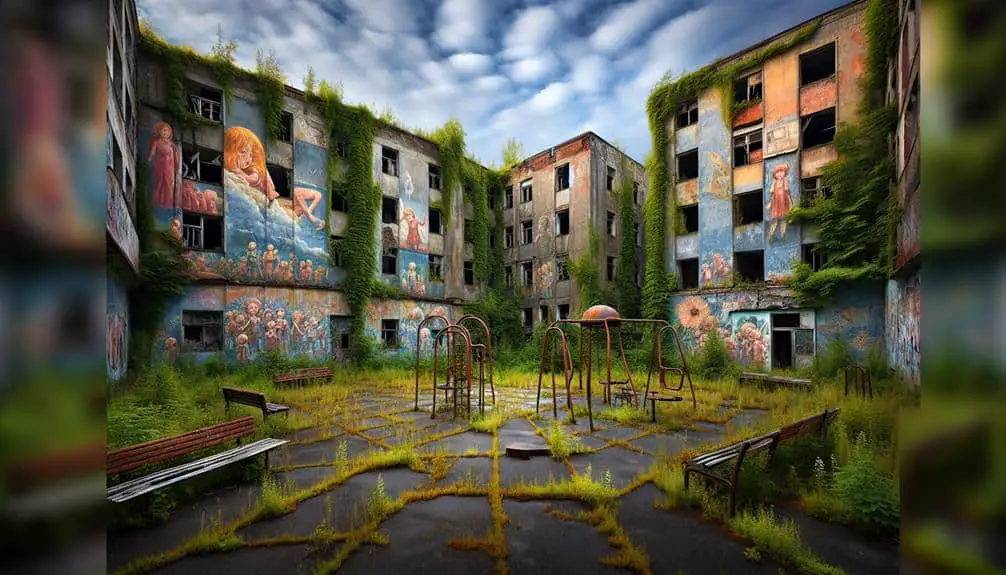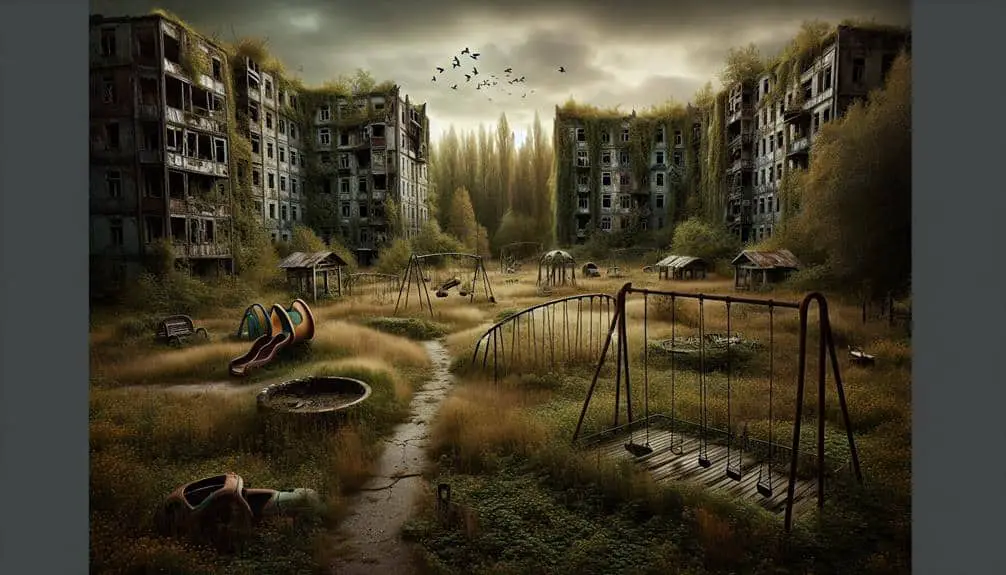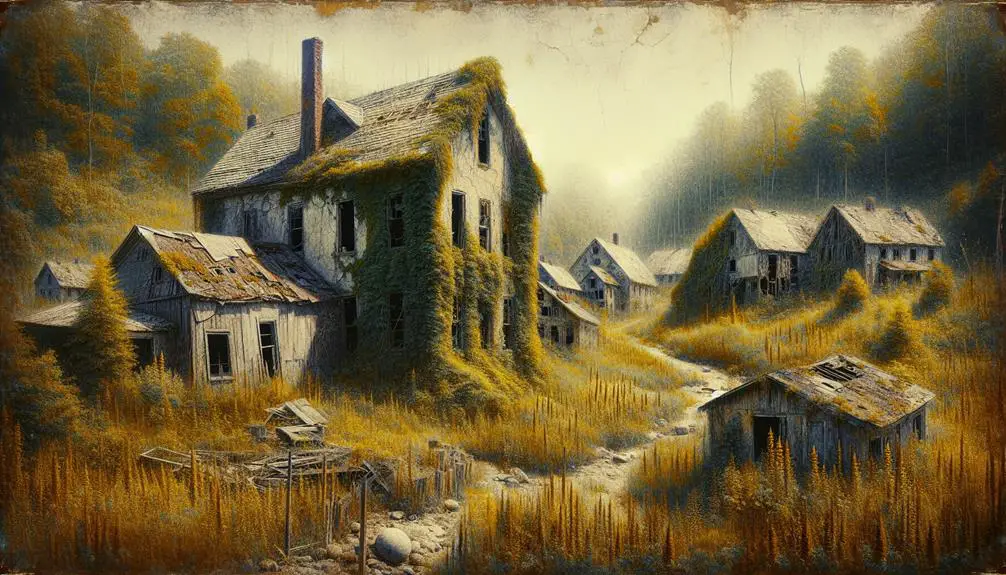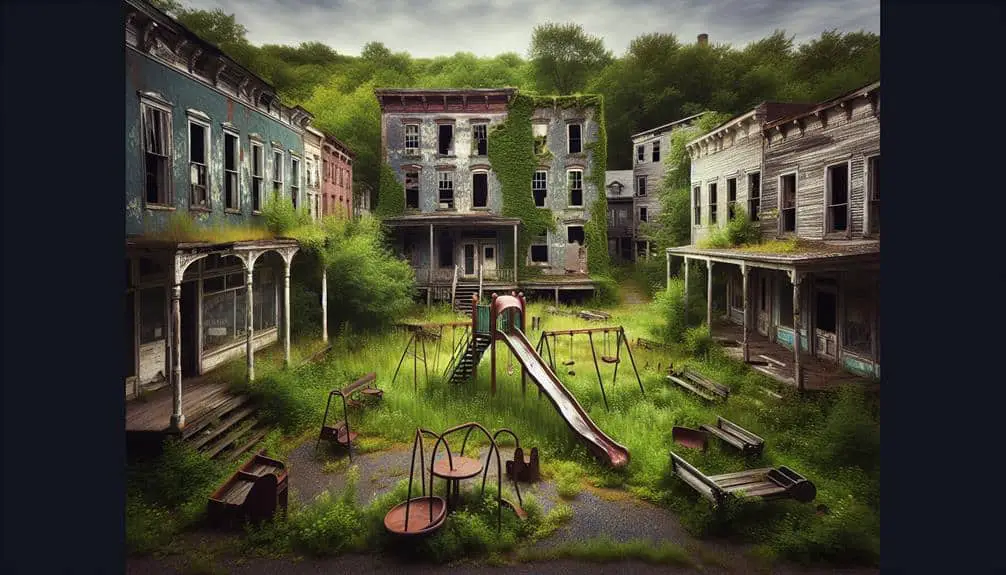Uncover the remnants of failed utopian experiments in American ghost towns. Explore the clash between communal ideals and individual freedoms that led to their decline. Witness the architectural grandeur of abandoned settlements, echoing aspirations of equality and cooperation. Investigate the intricate social structures and unique governance systems that once thrived in these communities. Discover how communal living and shared resources shaped economic decisions, fostering a sense of equality and cooperation. Each ghost town holds a cautionary tale and valuable lessons on community resilience. Immerse yourself in the faded tapestries of idealism and uncover the enduring quest for a better way of living.
Key Points
- Abandoned ghost towns reveal remnants of failed utopian experiments.
- Architectural ruins embody ideals of equality and cooperation.
- Social structures reflect intricate systems of collective governance.
- Economic systems emphasize communal living and shared resources.
- Lessons from lost utopias offer insights on community resilience and cooperation.
Origins of Failed Utopian Experiments
The origins of failed utopian experiments can often be traced back to a combination of idealistic fervor and practical challenges that clashed in the harsh realities of frontier life. In the 19th century, numerous utopian communities rose with the dream of creating perfect societies, only to eventually fall due to deep-seated ideological conflicts.
These communities, driven by a desire for freedom and equality, often faced internal struggles over differing visions of how their society should function. Idealism collided with the practicalities of sustaining a community, leading to a rise in tension and eventual decline. The clash between communal living and individual freedoms created rifts that widened over time, contributing to the downfall of these utopian experiments.
As these utopian dreams faded, many of these communities dissolved, leaving behind ghost towns that serve as reminders of the rise and fall of these ambitious but ultimately unsustainable ventures. The remnants of these failed utopias stand as attestations to the complexities of human nature and the challenges of translating idealistic visions into enduring realities.
Architectural Remnants of Utopian Dreams
Amidst the desolate landscapes of abandoned settlements, remnants of architectural grandeur stand as silent witnesses to the once vibrant utopian dreams that shaped these communities. Ruins exploration reveals the intricate designs and structures that were meant to embody the ideals of equality, harmony, and cooperation. Buildings like communal meeting halls, shared living spaces, and innovative structures reflect the aspirations of a society seeking a better way of life.
The architectural symbolism found within these remnants speaks volumes about the values and beliefs that drove the creation of these utopian settlements. The careful planning, unique layouts, and communal spaces all point towards a vision of a more interconnected and sustainable community. Despite the passage of time and the eventual decline of these settlements, the architectural remnants continue to evoke a sense of wonder and curiosity among those who explore them.
Through the study of these architectural remnants, one can gain insight into the hopes and aspirations of the past inhabitants and the enduring legacy of their utopian dreams.
Societal Structures in Abandoned Communities
Exploring the societal structures within abandoned communities reveals the intricate networks of social organization and governance that once shaped the daily lives of their inhabitants. In these forgotten utopias, collective governance played a central role in decision-making processes. Residents participated in communal living arrangements where shared responsibilities and resources were the norm. The societal fabric of these ghost towns reflected a sense of community and interconnectedness, with individuals contributing to the greater good of the whole.
Within these abandoned communities, unique systems of governance emerged, often based on principles of equality and cooperation. Residents worked together to establish rules, resolve conflicts, and maintain essential services. The spirit of collaboration and mutual support permeated the social structures of these lost utopian settlements.
As you explore the remnants of these abandoned communities, you witness the legacy of collective governance and communal living that once thrived within their walls. The echoes of a bygone era resonate through the deserted streets, reminding us of the ideals that once inspired these utopian visions.
Economic Systems of Forgotten Utopias
In dissecting the economic systems of forgotten utopias, one uncovers intricate webs of financial structures and resource allocation mechanisms that once sustained these abandoned communities. Within these utopian settlements, communal living was a central theme, where individuals pooled their resources to benefit the entire community. Shared resources were a fundamental aspect of their economic systems, ensuring that everyone had access to necessities and luxuries alike.
In these forgotten utopias, economic decisions were often made collectively through democratic processes, allowing each member of the community to have a voice in how resources were allocated and utilized. This communal approach fostered a sense of equality and cooperation among residents, promoting a more harmonious way of living.
Despite the eventual demise of these utopian communities and the transformation of their economic systems, the legacy of communal living and shared resources serves as a reminder of the potential for cooperation and mutual support in society. By studying the economic structures of these forgotten utopias, valuable lessons can be gleaned about sustainable resource management and the benefits of working together towards common goals.
Legacy and Lessons From Ghost Town Utopias
From the remnants of these abandoned utopian settlements emerges a profound legacy that offers valuable insights into sustainable community dynamics and cooperative resource management. The lessons learned from ghost town utopias shed light on the importance of community resilience in the face of challenges. These forgotten communities, with their failed but ambitious experiments, provide a blueprint for understanding the delicate balance between individual freedom and collective responsibility.
The legacy of ghost town utopias serves as a cautionary tale, highlighting the pitfalls of unchecked idealism and the need for pragmatic solutions in building sustainable societies. By examining the rise and fall of these communities, one can glean valuable lessons on the importance of adaptability, cooperation, and long-term planning in fostering thriving societies. The stories of these lost utopian visions underscore the enduring quest for a better way of living and the resilience of human spirit in the face of adversity. In exploring these ghost town legacies, one is reminded of the ongoing search for harmony between individual aspirations and communal well-being.
Frequently Asked Questions
How Did the Failed Utopian Experiments Impact the Surrounding Natural Environment in Ghost Towns?
When utopian experiments falter in ghost towns, their repercussions on the landscape are profound. The ecological consequences of failed visions leave scars on nature, altering the environment in unexpected and lasting ways.
What Role Did Art and Culture Play in Shaping the Architectural Remnants of Utopian Dreams in These Abandoned Communities?
Artistic expression and cultural influence are pivotal in shaping the architectural remnants of utopian dreams in abandoned communities. The fusion of creativity and societal values often manifests in unique structures that reflect historical aspirations.
Were There Any Unique Forms of Governance or Decision-Making Processes in the Societal Structures of These Abandoned Utopian Communities?
Like a symphony conductor guiding musicians, the unique forms of governance in abandoned utopian communities orchestrated decision-making processes. Democratic assemblies, consensus models, and communal councils were common, fostering inclusive participation and collective responsibility.
How Did the Economic Systems of Forgotten Utopias Influence the Local and Regional Economies After Their Collapse?
After the collapse of utopian communities, their economic systems had lasting effects on local and regional economies. The legacy impact led to societal transformation and cultural evolution. Economic repercussions were significant, shaping the economic landscape for years to come.
What Contemporary Movements or Communities Have Drawn Inspiration From the Legacy and Lessons of Ghost Town Utopias?
In today's world, you'll find contemporary movements and intentional communities that echo the ideologies of past ghost town utopias. They draw inspiration from the lessons learned, endeavoring to create their own versions of utopia.



